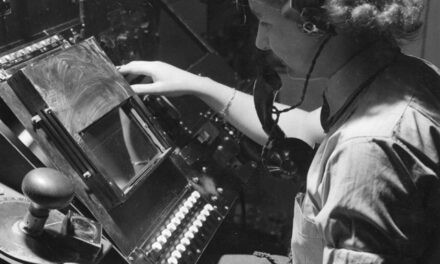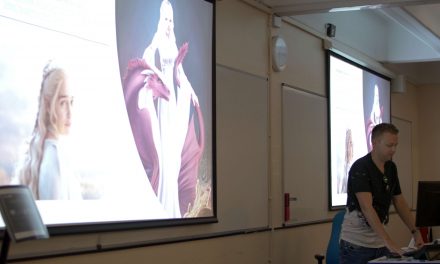Last time, I apologized to you for taking up your valuable minutes when you were probably all busy deciding which archival editions of the Radio Times or TV Times or TV Guide or other-listing-magazines-are-available to scatter around your home this Christmas. And this apparently threw a couple of people who are new to the world of television studies – probably because it was still November and at that point their tutors hadn’t got around to covering this tradition which normally forms part of the lectures and seminars given in the final week of the semester prior to dispersal for the festive period.
It’s a phenomena that I learned about when I was in my late teens, at university, and starting to dip my toe in the archival TV sub-culture in the days when if you heard that somebody had arranged a screening of Don Taylor’s The Exorcism (1972) double-billed with that 16mm print of Nigel Kneale’s The Year of the Sex Olympics (1968) that they’d just got back at the BBC in the basement viewing rooms of the British Film Institute (BFI) on Stephen Street, then you were skipping analogue electronics on Friday and at the metro interchange with your student travel card bright and early to have British Rail transport you to That London where subterranean televisual gems lay in wait.
I suspect that it was Dick Fiddy – the BFI television consultant and organizer of wonderful events such as Missing Believed Wiped and The Precious Things – who informed me of this ritual a good, oh, must be 35 years ago now. Probably when we were working on Primetime together. It was a tradition that evolved during the 1970s as television quite rightly took its place alongside film as a medium worthy of serious study, now that it was old enough to have its own history and even broadcast quiz shows about itself.
Basically, you save your Christmas editions of the Radio Times or TV Times or TV Guide or whatever each year, pop them in the loft with the Christmas tree and decorations, and then – come the first weekend of December – while you’re decking your halls you also select a few prime back issues to leave lying around the house (lounge, dining room, guest bedroom, DVD boudoir, etc.) during the yuletide season. In that No Man’s Land between Christmas and New Year, you can find yourself browsing through these slices of historic schedules, pondering on the Ghosts of Programmes Past. Visitors are delighted to discover seasonal obscurities when they drop around for drinks and nibbles, provoking rich conversation along the lines of “I’d forgotten that they did that Boxing Day special of Minder (1979-1994) where they just stuck bits of other episodes together” or “Did Raymond Francis really play Detective Chief Inspector Lockhart from No Hiding Place (1959-1967) and his own criminal dipsomaniac doppelganger in a semi-cross-over with Crane (1963-1965)?” [1] or “What? A BBC One schedule that doesn’t feature Pointless (2009-) or The Repair Shop (2017-)? Ummm, that’s not technically possible is it?” Well, you bet your sweet bippy…
There we go – a television studies festive tradition, every bit as important spiritually as watching The Box of Delights (1984), timed to coincide with the conclusion of Leave us not Little, nor yet Dark on Christmas Eve, just hours before you hear the approaching sound of Dasher, Dancer, Marshall, Rubble, Chase, Rocky, Zuma and Skye.
A vintage television guide also reminds you of how much television has changed across the years. For example, at Christmas 2020, my wife and I spent a good hour or so in the twilight zone twixt 26 and 31 December some fifty years earlier with the classic double-issue Radio Times for 19 December 1970 – 1 January 1971 (MIDLANDS edition [2]). First of all, you’re struck by the different shape of television: BBC1 only comes on air around 4.40pm most days and make that 7pm if you’re wanting to watch BBC2, both channels tend to close down and be tucked up in bed soon after midnight, it’s still acceptable to schedule old Norman Wisdom films in primetime on BBC1 and ballet or opera all evening on BBC2, and – yes – that film of the Flying Scotsman’s non-stop run from London to Edinburgh is on for the third year running.
One of the most modern things is still Colour television, with programmes using the technology emphasized by an over-excited typesetter as the italicized branding Colour is placed repeatedly to the right of the bold transmission time and above the bold programme title.
But beyond typography, it’s the vocabulary deployed in a time when there’s so little television to be had that it can all be sold to the reader that stands out. For example, take the billing for BBC1’s The Saturday Thriller on 19 December. Fame is the Name of the Game is described as ‘A feature film specially made for television.’ Imagine that, a feature film that is so special that you can’t pay to go to see it at the Odeon – this is of such high standards that it has to be shown on television in the comfort of your own home.
And, what’s more, it’s in Colour.
Of course, what this really is is a 1966 TV movie from the USA – in fact, it’s what was effectively the pilot episode of Universal’s lavish publishing drama-adventure The Name of the Game (1968-1971), a show that – for British viewers – had already debuted two years earlier on ATV (one of the commercial stations) in October 1968.
Now, at present, I’m just starting to get nostalgic for a good old TV movie. It all started with Tengy, the vlogger who was my guest on this blog at the start of term. Now, she doesn’t only talk about The Goodies (1970-1982), she’s far too multi-talented for that; she also does reaction videos to horror films, and recently these have included both Vampire (1979) and Moon of the Wolf (1972) – items that caught my attention because they have the same whiff of TV pilot telefantasy as The Night Stalker (1972) which is a favourite of mine. I was further reminded of this media-fusion, sometimes shunned by both TV and film camps, when reading Professor Christine Geraghty’s engaging ponderings in her own piece on this very website. So… after a course of exercises to increase my upper limb strength, I got out my copy of Alvin H Marill’s vast tome Movies made for Television (LSP Books Limited: 1980) and started to reacquaint myself with this imported art form which was once acceptable to shore up the primetime schedules of both BBC and ITV.
But the thing is that just because Fame is the Name of the Game is from a genre that by the 1990s tended to be referred to as a ‘tatty TV movie’ by those who overlook the fact that it’s the form of programming that gave us gems like the Richard Matheson-Steven Spielberg classic Duel (1971), it doesn’t mean that it shouldn’t be sold as something special to the reader. And at this point, the Radio Times is a BBC magazine designed to promote the BBC. Television is limited and what there is needs to be attractive to stop people tuning to Thames or LWT or ATV or Granada or all those other stations I told you about last time. Like the BBC’s teletext service Ceefax, God Rest Its Soul:
Now, here in the multi-channel all-day future, viewing time is what’s limited rather than the television to actually view. The modern Radio Times, now an independent title covering all major scheduled broadcasters, needs to select what it is best for us to watch and help us navigate the plethora of product on offer. Compare therefore the ‘specially made for television’ of 1970 to the ‘cheap, made-for-TV Christmas movies’ description offered in the 2020 double issue to deter the discerning viewer from tuning into Sony Movies Christmas.
But beyond the sell-sell-sell of archaeological listings magazines, it’s also the richness of language in general that’s employed, possibly in a manner less on display in this more accessible age where the average listing magazine looks less like the leisurely It Pays to Increase Your Word Power section of Reader’s Digest and has to cram in far too much into its too few pages like an Argos catalogue of all that’s best to view. I was reminded of this when I revisited Barrier Reef (1971) – an example of which aired on 21 December 1970 [3].
Now I loved watching Barrier Reef. That rousing theme tune from Eric Jupp as the jet-boats sliced through the surf heading away from the Endeavour, the waves broke over the camera, and the two-person mini-sub skirted over the coral with its ever-vigilant scuba team. It was the best thing going. I mean, WOW!, the exotic coastline of Australia, the Endeavour, floating home to the MINUS 5 project (Mineral Identification Nuclear Undersea Seismography Mark V) used by the General Trust Corporation’s scientific search and recovery team – Ted King, Jack Meuraki, Steve Gabo, Kip Young, Dr Hanna, Tracey Deane, Elizabeth Grant and Eli Maclure [4] – to locate mineral deposits while simultaneously fighting counterfeiters and uranium smugglers, rescuing cyclone survivors, foiling Mafia hits with aquatic antidotes and recovering radioactive parts of the ill-fated Apollo 13 mission.
Oh yes, and it was in Colour.
Now, this was the very first series that I made up stories about in my school books. Imagine that – Barrier Reef fan fic. And this increased my vocabulary thanks to the Radio Times.
You see, being an imported series, Barrier Reef often had a standard synopsis when the BBC weren’t 100% sure which episode they were going to air. It was a common thing. For Scooby Doo Where Are You! (1969-1970), every week you were promised ‘A new suspense-filled cartoon series, starring the members of Mystery Inc and their ever-hungry hound, Scooby-Doo.’ And for Barrier Reef, you knew that the weekly mantra would generally read:
‘An exciting Australian adventure series, filmed on location on the Queensland Great Barrier Reef, starring the skipper and crew of the barquentine Endeavour.’
And to create my unlicensed expanded universe tales of Ted King and his team, I had learned that word – B-A-R-Q-U-E-N-T-I-N-E – from the Radio Times… and had then quickly neglected it. I had forgotten that I even knew that word. And at the end of 2020, I suddenly rediscovered it, and realized that I had used ‘barquentine’ a lot in 1970, and never in the subsequent fifty years. Which seemed to be a bit of shame.
So, I figured I’d better make up for that…
_____________________________________
Andrew Pixley is a retired data developer. For the last 30 years he’s written about almost anything to do with television if people will pay him – and occasionally when they won’t. Dear Santa, do you have any copies of The Time Tunnel – Original Television Soundtrack – Volume Two left, and have his blogs this year been good enough to warrant a copy? And he hopes that everyone contributing to and reading CSTonline this year has a safe and happy holiday doing what they enjoy most with those dearest to them, particularly Hannah Cooper and Dr Victoria Byard who gave him and his wife possibly the happiest days of 2021.
Footnotes
[1] Yes, he did. It was called Deep & Crisp & Stolen and aired on 21 December 1964 in the Play of the Week strand.
[2] So… no Monty Python’s Flying Circus (1969-1972) then! Yes, I know it was BBC1 and not ITV, but BBC1 also has a lot of regional eccentricities of its own, and Series B of Monty Python’s Flying Circus was one of them. The final episode didn’t air in some episodes until 1987…
[3] Yes, I know I said (1971) in brackets and a moment later I’m giving a date in 1970. Look academia, I’ve been through this before and still nobody gave me an answer. This is an Australian series and it first aired in Australia on a regional basis during 1971, having filmed from 1969 to 1970. Can I help it if the BBC picked it up and screened it from October 1970 before the domestic transmission? Live with it…
[4] In erratic permutations and combinations depending on how out-of-sequence the episodes were.









